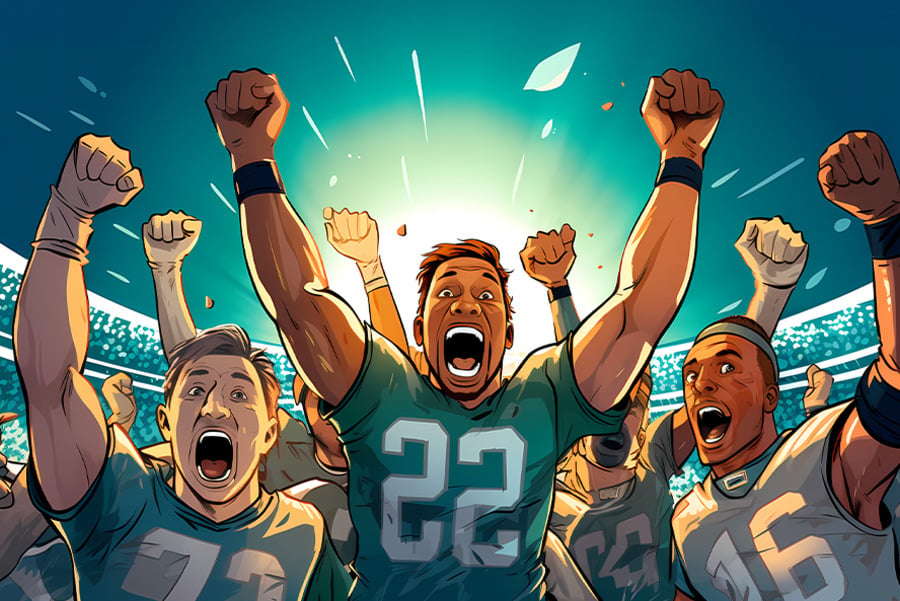Every year, millions of fans worldwide eagerly wait for the Super Bowl, a cultural juggernaut synonymous with sporting excellence and unparalleled entertainment. From its humble beginnings in 1967, The Super Bowl has evolved into a global cultural phenomenon. It also serves as an invaluable source of wisdom for event planners and organizers. In this blog, we glean through 13 pivotal lessons from the Super Bowl's legacy to learn how to organize a triumphant sporting event. From meticulous planning to fan engagement, join us in decoding the playbook for sports event management.
Major Challenges of Organizing A Successful Super Bowl
Organizing a successful Super Bowl presents many challenges that demand planning and strategic foresight. The three most significant challenges that organizers face are Safety and Security, Logistics and Infrastructure, and Fan Experience and Engagement.
Safety and Security:
The sheer scale of the Super Bowl, with thousands of spectators and high-profile individuals in attendance, elevates the importance of robust security measures. From threat assessments to emergency response plans, organizers must navigate the complexities of modern security challenges. Collaborations with law enforcement, intelligence agencies, and cybersecurity experts become imperative to safeguard against potential risks, ranging from terrorism threats to cyber attacks.
Logistics and Infrastructure:
The logistical intricacies of hosting a Super Bowl are immense. Coordinating the arrival and departure of teams, managing transportation for tens of thousands of spectators, and orchestrating the movement of equipment and personnel require meticulous planning. Infrastructure, including stadiums, roads, and accommodation, must meet the demands of the massive influx of visitors. Addressing these logistical challenges involves coordinating with local authorities, transportation agencies, and vendors to ensure seamless operations before, during, and after the event.
Fan Experience and Engagement:
With a multitude of events, fan zones, and interactive activities, the challenge lies in orchestrating these elements cohesively to maintain a high level of fan satisfaction. Balancing the expectations of diverse fan demographics, from die-hard football enthusiasts to casual spectators, requires a strategic approach. Incorporating innovative technologies, providing accessible and fan-friendly information, and curating a vibrant atmosphere contribute to a memorable experience.
Source: Image by WikiImages from Pixabay
What Super Bowl Teaches about Sports Event Management
Sports event management encompasses a wide range of tasks and responsibilities aimed at ensuring the successful organization and execution of a sporting event. By evaluating insights from the Super Bowl, sports event managers can explore valuable lessons in handling logistics, coordinating schedules, managing venues, overseeing security measures, and creating an engaging fan experience.
1. Detailed Planning:
Organizing a Super Bowl event entails an extraordinary level of planning, given its global magnitude and significance. According to Craig Gabber, the former director of stadium and event operations of Levi’s stadium, the planning for a Super Bowl starts two years prior to the actual day of the event.
Venue logistics, security measures, transportation coordination, and fan engagement strategies are pivotal factors that demand meticulous consideration. Frank Supovitz, former SVP of Super Bowl Events, emphasizes the critical importance of learning from mistakes and maintaining a realistic outlook in the planning process.
To be prepared for anything, event planners should prioritize risk mitigation, develop comprehensive contingency plans, and foster a culture of continuous improvement. A poignant example illustrating the need for adaptability is the unexpected blackout during Super Bowl XLVII. It underscores the importance of anticipating and effectively addressing unforeseen challenges in the intricate planning process.
2. Staff Training and Team Building
The process of staff training and team building in sports event management is a multifaceted approach for equipping professionals with the skills and knowledge necessary for successful event execution. It involves the development of certifications and specialized risk management courses tailored for event industry professionals on a range of topics, including logistics, safety protocols, crisis management, crowd control, and communication strategies.
Establishing standardized competencies is crucial to cultivating a unified and efficient team. This process entails defining the essential skills, knowledge, and expected behaviors for each team member. It fosters a shared understanding of roles and responsibilities within the group.
Concurrently, introducing hierarchical levels within the staff structure refines the team's organization. It categorizes roles based on expertise, creating a defined chain of command that facilitates efficient decision-making during events. Practical simulations and exercises are pivotal components, replicating real-life scenarios to enhance problem-solving, teamwork, and communication skills. Finally, continuous professional development is imperative to keep the team adaptable and well-versed in the latest trends, technologies, and best practices within the sports event industry.
Photo by Larry Bridges Jr. on Unsplash
3. Fan Engagement:
In sports event planning, fan engagement takes center stage, emphasizing interactive activities, dedicated fan zones, and strategic use of social media. The week preceding the Super Bowl is a crescendo of festivities, with sponsors like Sports Illustrated and Uber hosting exclusive parties. Brands like SiriusXM and Pandora host exclusive concerts for fans ahead of Super Bowl weekend.
Engaging attendees in secondary festivals and post-event parties is paramount, as these experiences transcend mere attendance, fostering a transformative connection. By creating memorable interactions, sports event organizers can turn casual customers into devoted fans, amplifying the event's impact and ensuring sustained enthusiasm.
4. Contactless Payments:
In the realm of sports event management, contactless payments bring a trifecta of benefits – unparalleled convenience, swift transactions, and enhanced security. During the Super Bowl 54 at Miami Hard Rock Stadium, fans utilized a contactless pay card at food and beverage kiosks for a streamlined purchasing process.
Many sporting events have embraced RFID wristband integrations, providing fans with a secure and effortless method for cashless transactions. This transformative approach ensures a frictionless and enjoyable experience, marking a significant advancement in the intersection of technology and sports event planning.
5. Partnering with Right Brands
Partnering with the right brands for a sports event is a methodical process that begins with defining the event's goals and objectives. Through comprehensive market research, organizers identify brands that align with the event's theme, values, and target audience.
Creating detailed brand profiles, understanding target markets, and tailoring proposals showcase a commitment to mutual benefit. A well-crafted presentation, initiated contact through official channels, and personalized outreach help in building relationships. Activation involves implementing marketing strategies and continuous communication, while post-event evaluations, analysis of key performance indicators, and feedback collection contribute to refining future partnerships. This systematic approach ensures a strategic and successful collaboration between sports events and their brand partners.
A notable example is the Super Bowl's collaboration with Budweiser, creating emotionally resonant commercials. Another example is how automotive brands like Ford and Chevrolet strategically showcase ads during the game, aligning messaging with the event's spirit to effectively engage a diverse audience.
6. The legendary HalfTime Show
The Super Bowl halftime show has evolved into a legendary spectacle, with some of the most memorable performances etching themselves into popular culture. Iconic displays, such as Shakira and Jennifer Lopez's dynamic showcase, have elevated the halftime entertainment to a cultural phenomenon.
The inclusion of celebrity performances adds an extra layer of allure, attracting diverse viewership and enhancing the overall entertainment value. Sporting events, by incorporating celebrity appearances, can significantly broaden their appeal, attract a broader audience, and create a buzz that extends far beyond the sports realm. This ultimately benefits from increased visibility and cultural impact.
7. Taking Security to the Next Level
The National Center for Spectator Sports Safety and Security (NCS4) has elevated event safety and security through multifaceted initiatives. This includes hosting training workshops to educate venue personnel on the latest security protocols. They also partner with industry groups to share best practices, and establish alliances with the U.S. Department of Homeland Security for access to advanced security intelligence. NCS4's proactive measures contribute to creating a safer environment for spectators, participants, and staff.
Robust access control systems also play a pivotal role in event security by preventing unauthorized access. Sporting events must embrace new-age event tech integrations such as RFID, wearable tech, and facial recognition to strengthen the entry authorization processes.
8. Utilizing Big Data and Tech Integrations
Big games in the sports industry wield a profound impact on data collection and analysis, leveraging vast datasets to revolutionize various aspects of the sports landscape. One crucial domain is fan engagement, where data analytics enables personalized interactions, and understands fan preferences, behaviors, and engagement patterns. Data collected from fan interactions in social media, ticketing platforms, official websites and apps can help tailor content to target niche demographics. Additionally, data-driven insights are pivotal in unlocking advertising opportunities, allowing targeted and relevant promotions to enhance the viewer experience.
In the realm of sports betting, big data plays a pivotal role in odds calculation and risk assessment. Accurate and timely data is crucial for sportsbooks to establish odds and manage in-play betting markets effectively. Sports organizations are capitalizing on this by providing official league data to betting operators, creating a symbiotic relationship that ensures the integrity of the betting process and opens up new revenue streams.
9. Promote Your Event Extensively
Promoting a sports event extensively is vital for maximizing attendance and broadening audience reach. Leveraging social media platforms allows for direct engagement with diverse demographics, fostering a sense of community and generating buzz. Traditional advertising channels, such as television and radio, complement this outreach by targeting broader audiences.
Collaborating with brands, both large and small, creates mutually beneficial partnerships, tapping into established audiences and enhancing credibility. A comprehensive promotional strategy, encompassing social media dynamics, traditional channels, and brand partnerships, ensures a multifaceted approach. It optimizes visibility and interest to ultimately boost attendance at the sports event.
10. Get Legal Approvals
Legal approvals play a vital role in sports event management, ensuring adherence to regulations, safety standards, and risk mitigation. The process involves identifying necessary permits, including venue, alcohol, and entertainment licenses.
Zoning variances and environmental impact assessments are crucial, requiring compliance with local regulations and environmental standards. Security clearances and safety approvals involve coordination with law enforcement. Health and safety certifications address concerns like food vendor compliance. Alcohol permits and gambling licenses must be secured, and comprehensive insurance coverage must be obtained.
Effective coordination with local authorities, timely submission of detailed applications, and continuous follow-up ensure a compliant and secure sports event.
11. Boost Logistical Efficiency
Managing a staff of 10,000-20,000 members for a large scale like the Super Bowl comes with its own sets of unique logistical challenges. Sports event managers rely on effective logistical planning to tackle these challenges and boost the overall operational efficiency of the event.
Logistical planning helps with optimal resource allocation, precise staff coordination, and timely operation of processes to make the sporting event a grand success. It also impacts the fan experience, helps anticipate logistical problems, and highlights the contingency plan to deal with problems.
To create a robust logistical plan for big-ticket events like the Super Bowl, the organizers should have a clear framework of the event flow with well-defined roles and responsibilities. It emphasizes comprehensive staff training and certifications, and a temporary decision-making hierarchy between various roles and teams.
12. Involve The Community
The Super Bowl actively involves the local community through initiatives like fan fests, volunteer opportunities, community outreach programs, and collaborations with local businesses. Post-event parties, marketing activations, and cultural showcases extend the excitement beyond the stadium. Legacy projects and charity events leave a lasting positive impact, investing in the local community's infrastructure and well-being. Through these efforts, the Super Bowl fosters a sense of inclusivity, community pride, and engagement, making the event more than a game but a celebration that benefits the residents of the host city.
13. Embracing Innovations
Embracing innovations in sports event management is crucial for staying competitive and enhancing the overall attendee experience. The Super Bowl exemplifies this by consistently incorporating cutting-edge technologies, entertainment formats, and marketing strategies. Recent innovations include augmented reality experiences, advanced analytics for player performance, and immersive virtual reality halftime shows.
The continual evolution of the Super Bowl showcases a commitment to offer novel and engaging experiences to fans while demonstrating the industry's capacity for adaptation and improvement.







